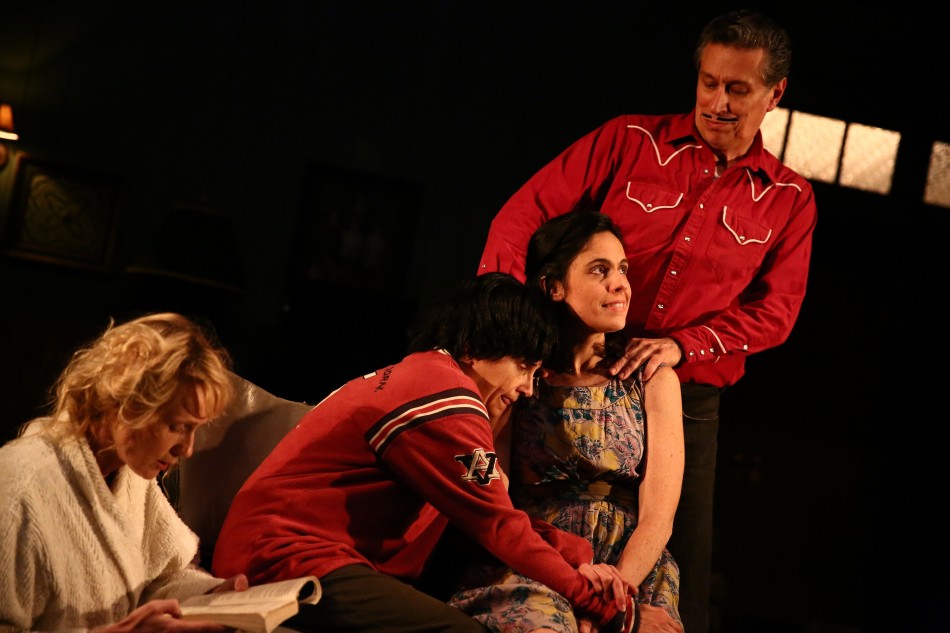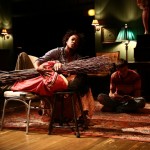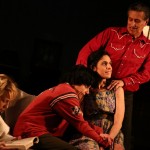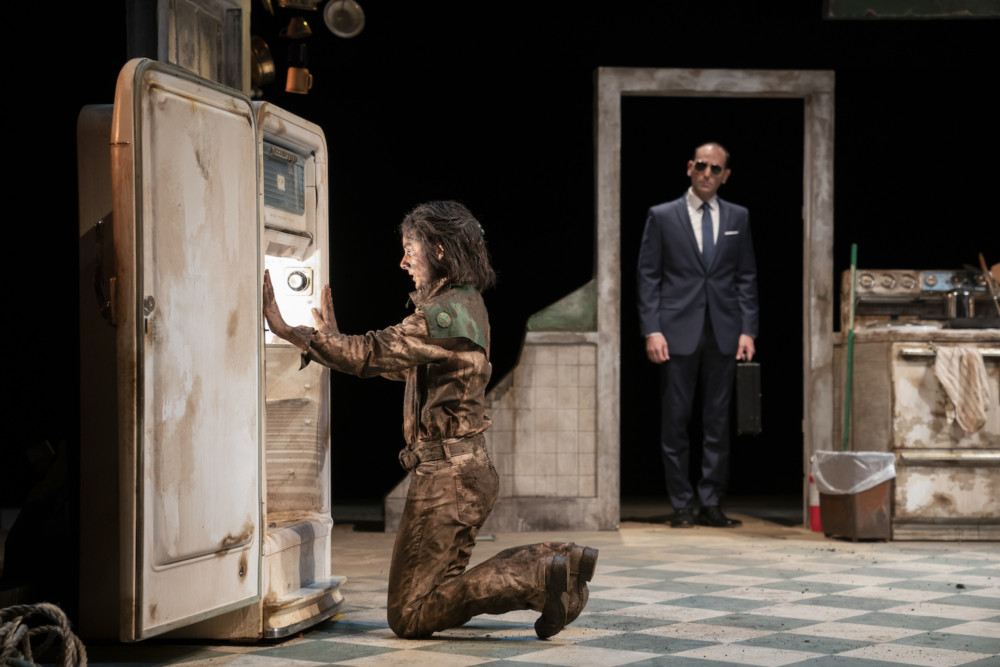Review by Samuel L. Leiter
There are presently two Off Broadway companies that specialize in adapting novels to the stage, Godlight Theatre Company and Elevator Repair Service (ERS). The former, whose Cool Hand Luke, directed by Joe Tantalo, is currently running at 59E59 Theaters, creates pared-down dramatizations, using relatively small casts with minimal means, while the latter, with bigger casts and larger budgets, actually performs the original work, including narrative descriptions and “he saids” and “she saids.” Their latest offering, William Faulkner’s The Sound and the Fury, directed by John Collins, is a revival of a work they first staged in 2008. It’s a brilliant, sometimes mesmerizing production but—ticket buyer beware—if you don’t know the book, or don’t remember your English professor’s lectures about it, you’re going to find it something of a slog.
Unlike ERS’s most famous production, the seven-hour Gatz (2009), which presented the full text of Fitzgerald’s The Great Gatsby, The Sound and the Fury runs a bit over a relatively miniscule two hours and fifteen minutes, albeit without an intermission; that’s because only the first of its four parts, “August 7, 1928” (the Benjy chapter), is presented. In contrast to Fitzgerald’s linear storytelling, Faulkner’s 1929 novel, much of it using a Joycean stream of consciousness, is famously opaque, and ERS makes things even more dense by having some roles played by more than one actor (sometimes simultaneously), some with blacks as whites and vice versa, with actors crossing the gender divide or playing children.
The Sound and the Fury takes its title from a line in Macbeth, a choice inspired by Benjy (mainly Susie Sokol, but also Aaron Landsman), the moaning, slobbering idiot (Faulkner’s word) at the heart of the story, which describes the decline of the decadent Compson family, once dignified and genteel but gone to seed and living on the remains of their plantation in Jefferson, Mississippi. Despite Benjy’s impairment, it’s through his disconnected memories at age thirty-three that we view the action, which shifts without warning back and forth in time between 1928 and 1898, as one or the others of the family engage in lust, castration, robbery, incest, and suicide.
Memory and reality collide in what can seem a jumble of episodes; only in the last two sections of Faulkner’s novel—not seen here—does the reader get a clearer picture of the horrific, tragic events. What the ERS staging so effectively does, of course, through its mingling of indoors, outdoors, years, genders, races, and multi-role actors, is to evoke the discombobulated sense of Benjy’s recollections. But sitting through parts of it can still be a trial.
Among the twenty-four characters are Benjy’s caring but promiscuous sister Candace, a.k.a. Caddie (Tory Vazquez, Kaneza Schall, Lucy Taylor, Rosie Goldensohn); his Mother (Mike Iveson, Vin Knight, Lucy Taylor, Greig Sargeant), the hypochondriacal matriarch who treats her children as crosses to bear; his brother, the morose, Harvard-bound Quentin (Mike Iveson, Aaron Landsman), Caddie’s sibling lover, who eventually drowns himself; Dilsey (Vin Knight, Daphne Gaines, Greig Sargeant), the faithful black cook; Caddie’s daughter, Quentin (Kaneeza Schaal), named for her uncle, as morally loose as her mother, who steals her hated uncle Jason’s (Mike Iveson, Vin Knight, Daphne Gaines) money; Luster (Ben Williams, Greig Sargeant), Dilsey’s seventeen-year-old son, caretaker for the adult Benjy, and so on.
Nearly everyone in the twelve-actor cast covers at least two roles, two play six, and one plays seven. Speeches are performed while reading from the book and without it; sometimes an actor narrates from the text while a scene is being performed by others. Now and then there are infusions of lively but oddball dancing to banjo music (Katherine Profeta is credited as the “movement dramaturg”). For all the glumness, the work isn’t without its lighter moments.
David Zinn’s impressive set fills the wide expanse of the Public’s Martinson Hall with the realistically detailed parlor of a Mississippi mansion, replete with two large, upstage archways. The many shabby chairs and other furnishings are mostly placed against the walls, with an assortment of different lamps nearby. A sideboard opens to become a fireplace by revealing a video fire inside. Down center are a stool and a tired metal kitchen chair with leatherette upholstery, ca. the 1950s, on and about which much of the action takes place. Exterior scenes, including golf games, happen inside the parlor.
Mark Barton introduces numerous lighting effects, both realistic and surrealistic, making memorable use of all the lampshades available, while projection designer Eva Von Schweinitz employs the wall between the arches to project passages from Faulkner, as well as information about the main characters. Colleen Werthmann’s costumes have a neutral period quality; they look somehow modern while also being strangely appropriate to the early twentieth century. And Matt Tierney outdoes himself with a multifaceted sound design, ranging from the literal to the otherworldly, including Benjy’s moans.
Audiences who know the book will relish this often hard-to-follow presentation for its ability to capture the Compson family’s decay with exceptional stagecraft and minutely observed acting from a polished ensemble. I can’t conceive of a more authentic way to bring Faulkner’s world to the stage. Still, reading The Sound and the Fury beforehand may prove useful; otherwise, you might, like several folks when I attended, find it easier to leave midway, or to catch up on your sleep.
*Photos: Paula Court
The Sound and the Fury
Public Theater/Martinson Hall
425 Lafayette Street, NYC
Through June 27

























